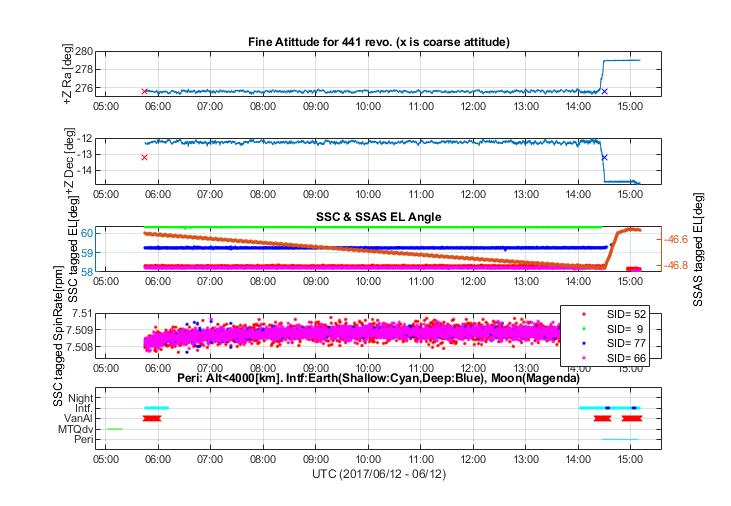Early studies on attitude determination for spinning spacecraft are devoted mostly to single-frame and batch spin-axis estimation methods. These methods give satisfactory results when the torques are negligible and the nutation has damped out, in other words when the spacecraft’s spin axis attitude is stationary. However, in general, the spin-axis attitude changes dynamically. Thus a sequential filtering algorithm with dynamics propagation is needed to estimate time-dependent attitude of the spacecraft together with the attitude rate. As a result, different attitude filtering algorithms have been proposed for spinning spacecraft.

Artist’s rendering of the Arase satellite on orbit (c) ISAS/JAXA
Many of the algorithms used for spinning spacecraft attitude determination were influenced from the methods for three-axis stabilized spacecrafts. However, these two estimation domains, attitude determination for spinning spacecraft and three-axis stabilized spacecraft, can never be completely same because of the basic differences. In fact, attitude estimation for spinning spacecraft is mostly more difficult. The attitude parameters and their rates change rapidly for spinning spacecraft. Moreover generally there is no gyro onboard so the Euler’s dynamics equations must be propagated as a part of the filtering equations.
This research focuses on design of new attitude determination algorithms for spinning spacecraft. The designed algorithm package incorporates not just the filtering algorithm for attitude estimation, but also other auxillary algorithms to improve the overall attitude estimation accuracy. Investigations are being carried on in collaboration with Prof. Shin-ichiro Sakai from ISAS/JAXA and the designed algorithms are being tested for the Arase (ERG) spacecraft of JAXA.

Attitude estimation results for Arase on 12 June 2017 from 5am to 3pm
Further reading:
- H.E. Soken, S. Sakai, K. Asamura, Y. Nakamura, T. Takashima and I. Shinohara, “Filtering-Based Three-Axis Attitude Determination Package for Spinning Spacecraft: Preliminary Results with Arase”, Aerospace, vol.17, no.7, 2020. DOI: 10.3390/aerospace7070097
- H.E. Soken, S. Sakai, K. Asamura, Y. Nakamura, T. Takashima and I. Shinohara, “Mission Experience for Spinning Spacecraft Attitude Filtering with Spin Parameters,” in Proc. 32nd International Symposium on Space Technology and Science, Fukui, Japan, 2019.
- H.E. Soken, S. Sakai, K. Asamura, Y. Nakamura and T. Takashima, “Study on an Advanced Attitude Determination Algorithm for the ERG Spacecraft,” in Proc. 26th International Symposium on Space Flight Dynamics, Matsuyama, Japan, 2017, ISTS-2017-d-075/ISSFD-2017-075.
- H.E. Soken, J. C. Van der Ha and S. Sakai, “Spinning Spacecraft Attitude Filtering with Spin Parameters: Performance Evaluation with Real Data,” in Proc. 26th International Symposium on Space Flight Dynamics, Matsuyama, Japan, 2017, ISTS-2017-d-078/ISSFD-2017-078.
- H.E. Soken, S. Sakai, K. Asamura, Y. Nakamura and T. Takashima,“Spin Parameters and Nonlinear Kalman Filtering for Spinning Spacecraft Attitude Estimation,” in Proc. 27thAAS/AIAA Space Flight Mechanics Meeting, San Antonio, TX, USA, 2017, AAS 17-249. Also in Advances in the Astronautical Science, vol. 160, pp. 2615 – 2629, 2017.
- H.E. Soken, J. C. Van der Ha and S. Sakai, “Spin-axis Tilt Estimation Algorithm with Validation by Real Data,” in Proc. 27thAAS/AIAA Space Flight Mechanics Meeting, San Antonio, TX, USA, 2017, AAS 17-250. Also in Advances in the Astronautical Science, vol. 160, pp. 2631-2645, 2017.